
A shrine to the Virgin Mary, or Marian shrine, is a shrine marking an apparition or other miracle ascribed to the Blessed Virgin Mary, or a site on which is centered a historically strong Marian devotion. Such locales are often the destinations of Christian pilgrimages.

The Basilica of Santa María de Guadalupe, officially called Insigne y Nacional Basílica de Santa María de Guadalupe is a basilica of the Catholic Church, dedicated to the Virgin Mary in her invocation of Our Lady of Guadalupe, located at the foot of the Hill of Tepeyac in the Gustavo A. Madero borough of Mexico City. It belongs to the Primate Archdiocese of Mexico through the Guadalupana Vicariate, which since November 4, 2018, is in the care of Monsignor Efraín Hernández Díaz, who has the title of general and episcopal vicar of Guadalupe and abbot of the basilica.
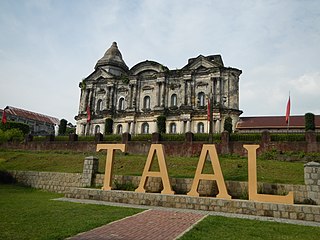
Taal, officially the Municipality of Taal, is a 3rd class municipality in the province of Batangas, Philippines. According to the 2020 census, it has a population of 61,460 people.
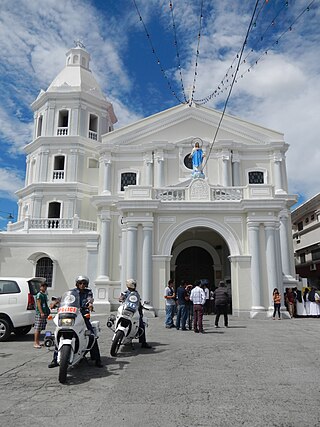
The Archdiocese of San Fernando is the archdiocese of the Latin Church of the Catholic Church in Pampanga, Philippines which has territorial jurisdiction over the whole province of Pampanga and Angeles City. The archdiocese is also the metropolitan see of the ecclesiastical province of the same name, which also include three dioceses of its surrounding provinces of Bataan, Zambales, and Tarlac. The cathedral church and seat of the archdiocese is the Metropolitan Cathedral of San Fernando (Pampanga). The Virgin Mary, under the title Virgen de los Remedios, is the principal patroness.
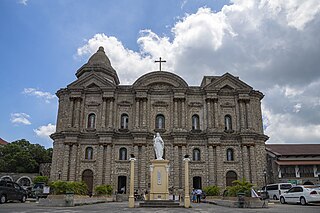
The Minor Basilica and Parish of Saint Martin of Tours, also known as the Taal Basilica, is a minor basilica in the town of Taal, Batangas, within the Archdiocese of Lipa. It is considered to be the largest church in the Philippines and in Asia, standing 88.6 meters (291 ft) long and 48 meters (157 ft) wide. Martin of Tours is the patron saint of Taal, whose feast is celebrated every November 11.

Our Lady of Caysasay is a Roman Catholic image of the Blessed Virgin Mary venerated at the Archdiocesan Shrine of Our Lady of Caysasay in Taal, Batangas, Philippines. The image depicts the Immaculate Conception is believed to be one of the oldest in the country, originally discovered in 1603 by a native man fishing in the Pansipit River. The subsequent Marian apparitions documented by Spanish colonial church leaders were the first in the country; devotees today continue to attribute miracles to the Virgin.

The National Shrine of Our Lady of the Candles, also known as the Metropolitan Cathedral of Saint Elizabeth of Hungary and colloquially as Jaro Cathedral, is a cathedral located in the district of Jaro in Iloilo City, on the island of Panay in the Philippines. The seat of the Roman Catholic Archdiocese of Jaro, it was placed under the patronage of Saint Elizabeth of Hungary. It was established in 1575 as a visita (chapel-of-ease) of Oton by the Augustinians and as a separate parish in 1587. The present-day structure of Jaro Cathedral was built in 1874.
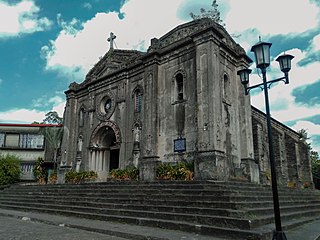
The Nuestra Señora de Gracia Church, also known as Guadalupe Church, is a Baroque Roman Catholic church in Makati City, Philippines. The parish church and its adjacent monastery are currently administered by the Augustinian friars of the Province of Santo Niño de Cebu. The territory of the parish covers San Carlos Seminary, the major seminary of the Archdiocese of Manila and Our Lady of Guadalupe Minor Seminary. The church also has an adjacent seminary, the Monasterio de Guadalupe, which admits young professionals for priestly and religious vocation. The current parish priest is Danilo M. Carido.

The Our Lady of Guidance is a 16th-century image of the Blessed Virgin Mary depicted as the Immaculate Conception and widely venerated by Filipinos. The wooden Black Madonna is considered the oldest extant Marian statue in the Philippines. Locally venerated as patroness of navigators and travelers, the image is enshrined at the Ermita Church in the city of Manila.

The Basilica Minore of Our Lady of Piat is one of the twenty-one minor basilicas in the Philippines. Located at Poblacion, Piat, in the province of Cagayan, it is the seat of the Roman Catholic Archdiocese of Tuguegarao. The shrine is dubbed as the Pilgrimage Center of Northeast Luzon and is home to the centuries-old brown Madonna Our Lady of Piat.

The Archdiocesan Shrine of Our Lady of the Assumption, commonly known as the Santa Maria Church, is a Roman Catholic shrine in Santa Maria, Ilocos Sur, Philippines. The church was designated as a UNESCO World Heritage Site on December 11, 1993, as part of the Baroque Churches of the Philippines, a collection of four Baroque Spanish-era churches.

The National Shrine of Our Lady of the Abandoned, also known as the Santa Ana Church, is a Spanish colonial period church located in the district of Santa Ana in Manila, Philippines. The parish was established by the Franciscan missionaries in 1578 under the patronage of Saint Anne. The present stone church was constructed by Vicente Inglés from 1720 to 1725 and was dedicated to its present patron, the Our Lady of the Abandoned. The revered image of its patron was made in Valencia, Spain in 1713 and arrived in the Philippines in 1717.

The Minor Basilica and Parish of the Immaculate Conception, alternatively known as the Archdiocesan Shrine of Santo Niño de Batangan, is a minor basilica in Batangas City, Philippines. It was made an independent parish in 1614 under the advocation of the Immaculate Conception. It is one of the oldest churches in Batangas.
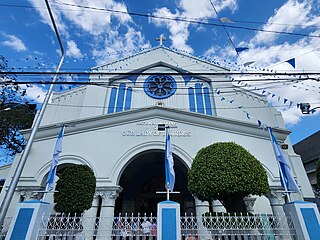
The National Shrine of Our Lady of Lourdes, better known as the Church of Lourdes de Manila, is a Catholic national shrine in Quezon City, Metro Manila, Philippines. The church is administered by the Order of Friars Minor Capuchin of the Philippine Ecclesiastical Province and under the Vicariate of San Pedro Bautista of the Latin Church diocese of Cubao.

The Our Lady of the Pillar Parish Church, commonly known as the Santa Cruz Parish Church and also designated as the Archdiocesan Shrine of the Blessed Sacrament, is a Mission Revival Roman Catholic parish church in the district of Santa Cruz, Manila, Philippines. It was built when the arrabal (suburb) of Santa Cruz was established by the Jesuits in the early 17th century. The church had undergone many repairs and reconstruction, with the last reconstruction done in the 1950s.
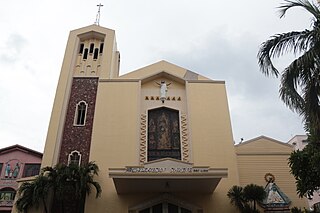
Sampaloc Church or the Archdiocesan Shrine of Our Lady of Loreto is a Roman Catholic Church located along Figueras Street in the district of Sampaloc in the City of Manila. The church is named after and dedicated to the Virgin Mary and her pilgrimage site in Loreto, Italy where tradition states as the site where the Mary's house was relocated.

The Archdiocesan Shrine and Parish of Saint James the Greater, commonly known as Ibaan Church, is a Roman Catholic shrine and parish church in the municipality of Ibaan, Batangas in the Philippines. Known for its Easter traditions of Bati and Dagit, the church was founded in 1817 while the current structure was built from 1853 to 1869.
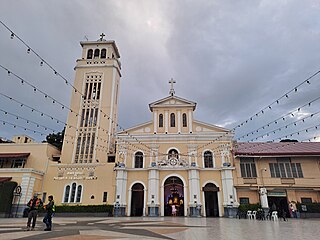
The Minor Basilica of Our Lady of the Rosary of Manaoag, commonly known as Manaoag Church, is a Roman Catholic minor basilica located in Manaoag, Pangasinan in the Philippines.

The Parish and National Shrine of Saint Padre Pio, commonly known as Padre Pio Shrine, is a Roman Catholic parish church and pilgrimage site situated along Governor Antonio Carpio Avenue in Barangay San Pedro, Santo Tomas, Batangas, Philippines. It is consecrated to the Italian Saint Pio of Pietrelcina.

The Diocesan Shrine and Parish of Our Lady of Mercy is a Roman Catholic church under the Diocese of Novaliches in the Philippines. It is the oldest parish in the diocese, established in 1856 by the Augustinian missionaries from Spain.


























